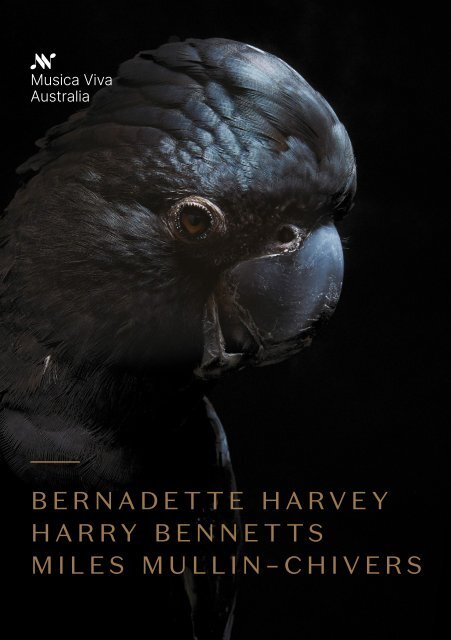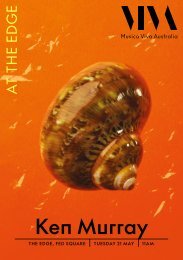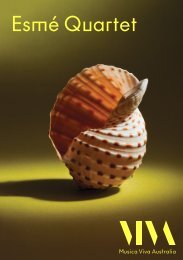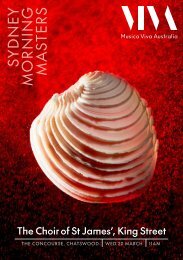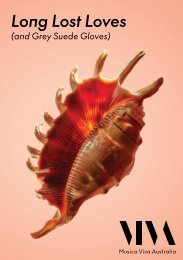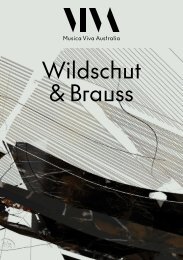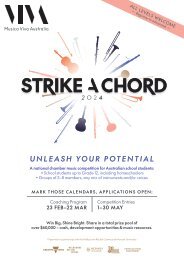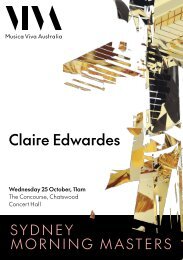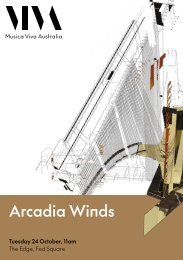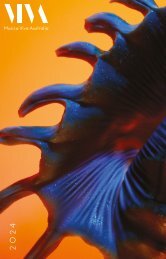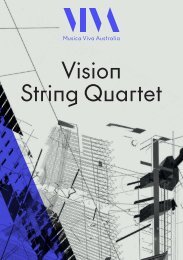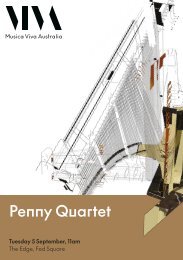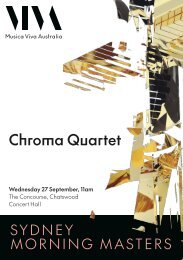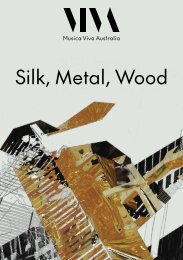Bernadette Harvey, Harry Bennetts & Miles Mullin-Chivers Program Guide | February 2022
You also want an ePaper? Increase the reach of your titles
YUMPU automatically turns print PDFs into web optimized ePapers that Google loves.
—<br />
BERNADETTE HARVEY<br />
HARRY BENNETTS<br />
MILES MULLIN–CHIVERS
Melbourne’s Finest<br />
Afternoon Tea Experience<br />
Discover The Langham Afternoon Tea at Aria Bar & Lounge and<br />
indulge in a selection of British tea time classics with a modern twist.<br />
#LovingLangham #CelebrateTheEveryday<br />
1 Southgate Avenue, Southbank, Vic 3006 Australia<br />
T (61) 8696 8888 F (61) 9690 5889<br />
langhamhotels.com/melbourne<br />
We’ve been taking orders and delivering fine<br />
wines to homes all across Australia since 1974.<br />
You won’t find our wine in bottle shops - we’ve<br />
always preferred to cut out the middle man.<br />
If you’re in Mudgee, come and see us at our<br />
beautiful winery and vineyard, try our wines<br />
and enjoy delicious local produce and weekend<br />
lunches in the gardens and grounds.<br />
As a friend of Musica Viva Australia, you are a<br />
friend of ours too, so take 20% off your first<br />
Huntington Estate order with coupon code<br />
MVAFRIEND, online or in our charming Cellar<br />
Door.<br />
641 ULAN ROAD BUCKAROO NSW 2850<br />
WWW.HUNTINGTONESTATE.COM.AU
Musica Viva Australia acknowledges the Traditional Custodians of the many lands on<br />
which we meet, work, and live, and we pay our respects to Elders past and present –<br />
people who have sung their songs, danced their dances and told their stories<br />
on these lands for thousands of generations, and who continue to do so.<br />
PROGRAM<br />
Donald HOLLIER (b 1934)<br />
A Little Sea Music (2021)<br />
[In five sections]<br />
15 min<br />
Ludwig van BEETHOVEN (1770-1827)<br />
Piano Trio in D major, Op. 70 No. 1 ‘Ghost’ (1809)<br />
30 min<br />
I Allegro vivace e con brio<br />
II Largo assai ed espressivo<br />
III Presto<br />
—<br />
Edvard GRIEG (1843-1907)<br />
Lento doloroso<br />
from Violin Sonata No. 2 in G major, Op. 13 (1867)<br />
Maurice RAVEL (1875-1937)<br />
Piano Trio in A minor (1914)<br />
I Modéré<br />
II Pantoum: Assez vif<br />
III Passacaille: Très large<br />
IV Final: Animé<br />
9 min<br />
28 min<br />
|<br />
3<br />
|<br />
With special thanks to the Producers’ Circle and the Amadeus Society of its support of the<br />
<strong>2022</strong> Concert Season, and to our Concert Champions Pam Cudlipp (NSW) and anonymous (ACT).<br />
CANBERRA HOBART SYDNEY NEWCASTLE<br />
THU 24 FEB,<br />
7PM<br />
MON 28 FEB,<br />
7:30PM<br />
MON 7 MAR, 7PM<br />
SAT 12 MAR, 2PM<br />
THU 10 MAR,<br />
7:30PM<br />
Llewellyn Hall,<br />
ANU School of Music<br />
Hobart Town Hall City Recital Hall Newcastle City Hall<br />
Meet the Artists<br />
after the concert.
ABOUT THE ARTISTS<br />
© Keith Saunders<br />
|<br />
4<br />
|<br />
<strong>Bernadette</strong> <strong>Harvey</strong> piano<br />
<strong>Bernadette</strong> <strong>Harvey</strong> is Senior Lecturer<br />
in Piano at the Sydney Conservatorium<br />
of Music. An acclaimed international<br />
performer and teacher, she was awarded<br />
the Centenary Medal in 2000 by then<br />
Prime Minister, John Howard, for her<br />
contribution to Australian music. Dr <strong>Harvey</strong><br />
has won many accolades since her first<br />
medal in a Sydney Eisteddfod at the age<br />
of two and a half, including the ABC Young<br />
Performer of the Year in 1987.<br />
As guest artist for the past 11 years at the<br />
Tucson Winter Chamber Music Festival,<br />
Arizona, she has worked with such artists<br />
as Ani Kavafian, Joseph Lin, Antonio Lysy,<br />
Paul Coletti, Alan Vogel and David Schifrin.<br />
She presented the world premiere there<br />
of a piano quintet by Pierre Jalbert and<br />
performed with the Tokyo Quartet in Carl<br />
Vine’s Piano Quintet, Fantasia (premiered in<br />
2013 with the Shanghai Quartet in Tucson<br />
and again in Australia for the Melbourne<br />
Festival in October 2013). She and the<br />
Shanghai Quartet presented the Australian<br />
premiere of the Bright Sheng Piano<br />
Quintet, Dance Capriccio. More recently<br />
she has released a CD, Alchemy, with the<br />
acclaimed Jupiter Quartet, recorded in<br />
2019 for the Canadian label Marquis, which<br />
was nominated for a Grammy Award.<br />
<strong>Bernadette</strong> <strong>Harvey</strong> performs regularly<br />
with Musica Viva Australia and with the<br />
ABC. She has had several new piano<br />
works written for her, including Rubia<br />
by Melbourne composer Tim Dargaville<br />
which she premiered in Melbourne with<br />
the Academy of Melbourne Orchestra,<br />
and by Ross Edwards, and Donald Hollier.<br />
She recently gave the Australian premiere<br />
of Night, the first piano concerto by her<br />
American colleague Kevin Puts, performed<br />
with the Llewellyn Sinfonia, conducted<br />
by her sister Rowan <strong>Harvey</strong>-Martin in<br />
Canberra.
<strong>Harry</strong> <strong>Bennetts</strong> violin<br />
Sydney-born violinist <strong>Harry</strong> <strong>Bennetts</strong><br />
began lessons in the Suzuki method at<br />
the age of four; and spent his final years<br />
of study with Dr Robin Wilson at the<br />
Australian National Academy of Music,<br />
and then with the Berlin Philharmonic<br />
Orchestra’s concertmaster Noah Bendix-<br />
Balgley at the Karajan Academy in Berlin.<br />
He has appeared as soloist with the<br />
Sydney, Melbourne, Tasmanian and<br />
Canberra Symphony Orchestras and<br />
has performed in recital at Ukaria (SA),<br />
Melbourne Recital Centre, and Sydney<br />
Opera House Utzon Room, as well as a<br />
number of regional centres. His love of<br />
chamber music has taken him across the<br />
world performing in the Berlin Philharmonie<br />
Kammermusiksaal, Cologne Philharmonie,<br />
London Southbank Centre, Prussia Cove<br />
and back home at the Australian Festival<br />
of Chamber Music in Townsville as well<br />
as regular performances in Sydney and<br />
Melbourne. <strong>Harry</strong> appears courtesy of the<br />
Sydney Symphony Orchestra, where he is<br />
Associate Concertmaster.<br />
<strong>Miles</strong> <strong>Mullin</strong>-<strong>Chivers</strong> cello<br />
<strong>Miles</strong> <strong>Mullin</strong>-<strong>Chivers</strong> began playing the<br />
cello when he was four years old. At age<br />
19, <strong>Miles</strong> completed his Bachelor of Music<br />
Performance with First-Class Honours<br />
at the Sydney Conservatorium of Music,<br />
having studied under Julian Smiles.<br />
He has also been taught by Fred Sherry,<br />
Tamás Varga, Timothy Walden, Hannu<br />
Kiiski, Howard Penny, Wolfgang Emanuel<br />
Schmidt, Philippe Muller and Kasia Hans,<br />
with whom he continues to study. <strong>Miles</strong><br />
performed as a soloist at the Canberra<br />
International Music Festival in 2018<br />
and 2019 and won the 2019 Gisborne<br />
International Music Competition. He has<br />
performed as a guest musician with the<br />
Sydney Symphony and Opera Australia<br />
orchestras.<br />
|<br />
5<br />
|
ABOUT THE MUSIC<br />
|<br />
6<br />
|<br />
Donald Hollier writes:<br />
Late in 2019, and shortly after the<br />
appointment of Paul Kildea as Artistic<br />
Director of Musica Viva Australia, I was<br />
approached with the suggestion to write<br />
a trio.<br />
I was somewhat hesitant at first. Although<br />
I had written a great deal of chamber<br />
music during my early years, I found the<br />
medium generally rather limiting. This<br />
was particularly apparent after I began<br />
to receive invitations and commissions<br />
to write large-scale works for orchestras<br />
and operas. Although I have continued to<br />
write songs and other smaller works for<br />
voices, instrumental chamber music was<br />
more or less abandoned. Consequently, I<br />
had written nothing for small instrumental<br />
groups for at least 40 years.<br />
After much thought, I decided it might do<br />
me some good to concentrate my musical<br />
ideas into this very concise form.<br />
When I think of chamber music, it is to<br />
recall the great period of its composition<br />
in the Classical period of Haydn, Mozart<br />
and Beethoven. These masters produced<br />
works of incredible structure and precision.<br />
They can never be imitated.<br />
Chamber music in the following centuries<br />
represented the broadening of the medium<br />
with Romantic, Impressionistic and<br />
Expressionistic colours. The upshot of all<br />
this thought determined me to attempt to<br />
reduce the scale of my work and accept<br />
the offer.<br />
As I was in the concluding stages of two<br />
operas, I put the commission aside for a<br />
number of months. I completed operas<br />
15 and 16 during the holiday period of<br />
2020-2021. The year 2020 was the first<br />
year of COVID-19 lockdowns which for<br />
a composer meant long days alone with<br />
little to do but compose, particularly as I<br />
am now in my 86th year with few social<br />
activities.<br />
I began work on the trio in January 2021.<br />
Paul Kildea is a world authority on the<br />
music of Benjamin Britten, and I thought it<br />
might be a nice gesture to write a theme<br />
and variations on a theme of Britten as a<br />
tribute to his academic standing.<br />
But which theme? Britten has written<br />
so much famous music with many<br />
possible themes. I had already in my<br />
youth written a theme and variations<br />
on the famous dodecaphonic theme in<br />
Cantata Academica written for the 500th<br />
Anniversary of Basel University. This is<br />
a brilliant work with an abundance of<br />
harmonic and contrapuntal devices.<br />
I considered this theme again but rejected<br />
the idea. Eventually I decided on the<br />
beautiful opening of Act 1, Scene 1 of<br />
Britten’s opera Peter Grimes. It flowed not<br />
only as a theme but as a beautiful ‘Aubade’<br />
in its own right.<br />
After transcribing this theme, I realised<br />
that the theme I had chosen was really<br />
unsuitable for ‘normal’ variation form.<br />
The melody, while marvellously serene,<br />
is without any rhythmic or harmonic<br />
variation. What should I do? Begin again?<br />
The idea sprang upon me that I should use<br />
the theme to bounce onto other poems<br />
about the sea. I was fortunate to have one<br />
of Australia’s finest pianists, <strong>Bernadette</strong><br />
<strong>Harvey</strong>, as the keyboard lead. In early<br />
discussions, she had expressed a wish for<br />
some ‘water music’. I certainly could not<br />
use the title ‘Water Music’ after Handel<br />
had written such famous music under that<br />
name. I therefore decided to call the work<br />
Small Sea Songs. They turned into a work<br />
like Mendelssohn’s ‘Songs Without Words’<br />
except that mine should really be ‘Songs<br />
with Words’, but the actual words of each<br />
poem not used. The words, however, were<br />
the impetus for each song.
There were of course now multiple choices<br />
available for sea poems. I decided on four<br />
of my favourites:<br />
1. Break, break, break<br />
On thy cold grey stones, O sea<br />
(Alfred, Lord Tennyson)<br />
2. Dead seamen, from Beach Burial<br />
(Kenneth Slessor)<br />
3. Many waters cannot quench love.<br />
Neither can floods drown it.<br />
(Song of Songs Ch. 8 Verse 7)<br />
4. I must go down to the sea again,<br />
To the vagrant gypsy life<br />
(from Sea Fever – John Masefield)<br />
Somehow from that decision, the trio<br />
flourished boldly and within two or three<br />
weeks, the work was completed with a fair<br />
copy made.<br />
NB: The composer has created an<br />
additional movement for this tour, a Lento<br />
tranquillo which appears between the third<br />
and fourth movements.<br />
© DONALD HOLLIER 2021<br />
Though composed in the same year as<br />
the mighty ‘Emperor’ piano concerto,<br />
1809, Beethoven’s D major Piano Trio is<br />
quite unlike it in character, the first two<br />
movements of the Trio displaying unrest<br />
and anxiety. The first movement – Allegro<br />
vivace e con brio – opens with a theme<br />
played in octaves by the three instruments<br />
and is quickly followed by a lyrical theme<br />
on the cello. This is the material from which<br />
the movement is mainly constructed. The<br />
development is lengthy, and contrasts are<br />
achieved by extreme changes of texture. A<br />
driving passage in unison or octaves gives<br />
way to contrapuntal imitations: a brief lyric<br />
interlude is interrupted by a vehement<br />
outburst of sound.<br />
The uneasy atmosphere manifest<br />
throughout the first movement continues<br />
to be felt in the splendid slow movement,<br />
which begins with the violin and cello in<br />
octaves. An eerie figure, repeated without<br />
cessation throughout the movement<br />
is, according to musicologist Gustav<br />
Nottebohm, to be found in Beethoven’s<br />
sketches for the opening scene of<br />
Macbeth, a project which came to nothing.<br />
The weird effect is heightened in the Trio<br />
by the introduction of light tremolo chords<br />
in the piano. It is the desolation of this<br />
music which suggested the nickname<br />
of ‘Geister’ (Ghost) for the work. Several<br />
despairing climaxes are developed and die<br />
away in long descending scales. Like the<br />
opening movement, the slow movement is<br />
constructed from a minimum of material,<br />
but its overall effect is awe-inspiring.<br />
The finale, Presto, is in sonata form, and<br />
does not attain the heights of inspiration<br />
reached by the preceding movements. It<br />
is neither so concentrated nor so intense.<br />
Despite this however, throughout it there<br />
is the same compulsion to make much<br />
of little, the development principle taking<br />
possession of the entire movement. It<br />
is this characteristic which makes the<br />
D major Trio one of Beethoven’s most<br />
passionate utterances in the sphere of his<br />
chamber music.<br />
© MUSICA VIVA AUSTRALIA<br />
|<br />
7<br />
|
|<br />
8<br />
|<br />
Grieg’s Second Violin Sonata, written at<br />
age 23 when he was on his honeymoon,<br />
was one of the first identifiably ‘Norwegian’<br />
works of his career.<br />
Pointedly, it was dedicated to Norwegian<br />
composer and violinist Johan Svendsen.<br />
Far from the ‘sunny’ disposition of<br />
its predecessor, it was described by<br />
composer Gerhard Schjelderup as ‘the<br />
gift to the world of a man who has also<br />
shivered in the cold mists of night’. Grieg<br />
himself said it was explicitly a Norwegian<br />
piece, and that ‘a Norway without tragedy<br />
is not a complete Norway.’<br />
For Grieg’s Danish composition teacher<br />
Niels Gade, it was ‘too Norwegian’, and<br />
he demanded that his student’s next<br />
sonata should be less so. ‘On the contrary,<br />
Professor,’ Grieg answered, ‘the next<br />
one will be even more so.’ Soon they<br />
would part ways; in Grieg’s case, toward<br />
international stardom.<br />
This sonata was premiered by Gudbrand<br />
Bøhn (who’d also played Grieg’s First<br />
Sonata), with the composer at the piano,<br />
in the autumn of 1867. This concert will<br />
feature the first of the sonata’s three<br />
movements. In it, the spirit of peasant<br />
folk dances is never far away. The piano<br />
part sometimes resembling a guitarist<br />
strumming a rhythm.<br />
ADAPTED FROM A NOTE<br />
© MARTIN BUZACOTT 2018<br />
In August 1914 Maurice Ravel wrote to his<br />
friend Maurice Delage: ‘If only you knew<br />
how I am suffering. From morning to night,<br />
I am obsessed with one idea that tortures<br />
me… If I leave my poor old mother, it will<br />
surely kill her… But so as not to think of this<br />
I am working, yes, with the sureness and<br />
lucidity of a madman. At the same time, I<br />
get terrible fits of depression and suddenly<br />
find myself sobbing over the sharps and<br />
flats!’.<br />
This glimpse of distress in a composer<br />
noted for a calculated and methodical<br />
approach to his work (and a tendency to<br />
cool irony when discussing his life) is at<br />
first surprising. But the outbreak of World<br />
War I deeply upset him. Elsewhere he<br />
writes: ‘This perpetual nightmare is too<br />
atrocious. I feel I shall go mad…’ The war<br />
threatened the culture which he loved, and<br />
he was terribly concerned for the safety of<br />
his friends such as the young Stravinsky.<br />
Ravel was also determined to serve his<br />
country, despite the fact that he was now<br />
39 years old, short and underweight. In<br />
September he was caring for the wounded<br />
in a voluntary capacity; by the following<br />
March he was a military truck driver. With<br />
his truck Adelaïde he faced a number of<br />
potentially fatal dangers.<br />
Ravel’s small output is a result of his<br />
perfectionism; he had begun his Trio in<br />
the summer of 1913 and, characteristically,<br />
completed only one movement – the first<br />
– by March 1914. Other works distracted<br />
him from the piece, which he clearly found<br />
challenging to write, but the outbreak of<br />
the war and his determination to enlist<br />
(despite the effect this might have on<br />
his much-loved mother) drove him to<br />
complete it in, for him, record time. And<br />
yet we must agree with scholar Rollo<br />
Myers, that ‘considering the conditions<br />
under which the work was composed,<br />
one can only marvel at its perfection and<br />
apparently unruffled equilibrium – with the<br />
possible exception of the last movement<br />
which shows some signs of nervous<br />
tension, although it is exultant and not at<br />
all tragic.’<br />
The opening movement is an expansive<br />
sonata design based on the attractive<br />
simple theme announced by the piano at<br />
the start. Ravel described it as ‘Basque in<br />
colour’; its rhythm, like much folk music,<br />
contains subtle irregularities (here, each<br />
bar is initially divided into groups of 3+2+3<br />
quavers) while the harmony is essentially<br />
simple and modal. The title of the second<br />
movement, Pantoum, refers to a style of<br />
Malay poetry (pantun) introduced into
French letters by Victor Hugo and much<br />
used by Charles Baudelaire. Its form<br />
demands that the second and fourth line<br />
of one stanza become the first and third of<br />
the next stanza. This doesn’t ‘translate’ into<br />
musical form, of course, though we might<br />
hear echoes in Ravel’s contrast of rhythmic<br />
groups of three and two, and in the way<br />
he alternates thematic material between<br />
strings and piano.<br />
the writing for all instruments is hugely<br />
virtuosic. One might suggest that for Ravel<br />
there was a kind of salvation from the<br />
imminent horrors of war in the virtues of<br />
Classical, lucent structures and textures.<br />
© GORDON KERRY 2018<br />
The exotic brilliance of the Pantoum is<br />
in complete contrast to the celebrated<br />
passacaglia (Passacaille) which follows.<br />
It is tempting to hear it as a kind of hymn<br />
to peace, the poised theme passing from<br />
instrument to instrument as Ravel gradually<br />
elaborates the texture and then, after the<br />
movement’s climax, gradually reduces it<br />
to its original state. The Final is, as Myers<br />
says, exultant. Ravel uses typically Basque<br />
rhythmic devices, such as the alternation<br />
of five and seven beats to a bar, and<br />
Journey into the Chamber of Musical Curiosities<br />
Hosted by Artistic Director Paul Kildea, the Chamber of<br />
Musical Curiosities is a podcast exploring the world of music<br />
in and around Musica Viva Australia. During the episodes,<br />
guests reflect upon creativity, their careers, and their passion<br />
for chamber music.<br />
Episode 10: Kim Williams<br />
In this episode, Kim discusses the various careers he’s had<br />
throughout his remarkable life. They explore the importance<br />
of Australian musicians, composers and learning the history of<br />
Australian music culture and musical traditions. Paul and Kim<br />
also have a heartfelt reflection on their mutual friend Richard<br />
Gill and his advocacy for music education in Australia.<br />
Listen on Spotify, Apple Podcasts or our website<br />
to come with us inside the Chamber of Musical<br />
Curiosities and explore a collection of musical<br />
marvels.<br />
musicaviva.com.au/podcast
SUPPORTERS<br />
|<br />
10<br />
|<br />
CUSTODIANS<br />
We gratefully acknowledge all Musica Viva Australia<br />
Custodians, whose future bequests will enable a lasting<br />
legacy of live music across Australia. All our Custodians<br />
are listed on our website.<br />
LEGACY DONORS<br />
NSW The late Charles Berg, The late Janette Hamilton,<br />
The late Dr. Ralph Hockin in memory of Mabel Hockin,<br />
The late Beryl Raymer, The late Kenneth W Tribe AC<br />
ENSEMBLE PATRONS<br />
Our artistic vision for <strong>2022</strong> is made possible thanks to the<br />
extraordinary generosity of our Ensemble Patrons, each of<br />
whom supports the presentation of an entire national tour<br />
for our <strong>2022</strong> Season.<br />
Ian Dickson & Reg Holloway (Van Diemen’s Band)<br />
Anonymous (Paul Grabowsky & Andrea Lam)<br />
Peter Griffin AM & Terry Swann as part of<br />
The Travellers - Giving Circle (A Winter’s Journey)<br />
Australian Music Foundation (Z.E.N. Trio)<br />
Eleanore Goodridge OAM (Avi Avital & Giovanni Sollima)<br />
CONCERT CHAMPIONS<br />
The mainstage concerts of our <strong>2022</strong> Season are brought<br />
to life thanks to the generosity of our Concert Champions<br />
around the country.<br />
ACT ACT Committee, Andrew Blanckensee,<br />
Humphries Family Trust, Dr Sue Packer,<br />
Sue Terry & Len Whyte, Anonymous<br />
NCLE Newcastle Committee, Megan & Bill Williamson<br />
SYD Patricia Crummer, Pam Cudlipp, Dr Jennifer<br />
Donald & Mr Stephen Burford, Charles Graham - in<br />
acknowledgement of his piano teacher - Sana Chia,<br />
Anthony Strachan, Kay Vernon, Kim Williams AM &<br />
Catherine Dovey (2), Ray Wilson OAM<br />
PRODUCERS’ CIRCLE<br />
Darin-Cooper Family Foundation<br />
AMADEUS SOCIETY<br />
The Amadeus Society is a group of passionate music<br />
lovers and advocates in Sydney and Melbourne who<br />
have joined together to support the extraordinary<br />
artistic initiatives of Musica Viva Australia.<br />
NSW Tony Berg AM & Carol Berg, Ms Jan Bowen AM,<br />
Tom Breen & Rachael Kohn AO, David Constable AM<br />
& Dr Ida Lichter, Ms Annabella Fletcher, Liz Gee,<br />
Dr Annette Gero, Katherine & Reg Grinberg, Jennifer<br />
Hershon & Russell Black, Michael & Fréderique Katz,<br />
Ruth Magid & Bob Magid OAM, Andrew Rosenberg,<br />
Ray Wilson OAM<br />
MASTERCLASSES<br />
GIVING CIRCLE<br />
The Masterclasses Giving Circle is a group of generous<br />
donors whose collective support will enable the artistic<br />
development of the next generation of Australian chamber<br />
musicians.<br />
Nicholas Callinan AO & Elizabeth Callinan, Caroline &<br />
Robert Clemente, Allan Myers AC QC & Maria Myers AC,<br />
Patricia H. Reid Endowment Fund, Andrew Sisson AO &<br />
Tracey Sisson, Mick and Margaret Toller, Anonymous (2)<br />
COMMISSIONS<br />
Musica Viva Australia acknowledges and celebrates those<br />
individuals and collectives who have generously committed<br />
to commissioning new music in <strong>2022</strong>/23 to be enjoyed by<br />
us all.<br />
In loving memory of Jennifer Bates; Julian Burnside<br />
AO QC & Kate Durham; The Barry Jones Birthday<br />
Commission; Michael & Fréderique Katz, in honour of<br />
Cecily Katz; Graham Lovelock & Steve Singer; DR & KM<br />
Magarey; Vicki Olsson; Tribe family in honour of Doug<br />
Tribe’s 75th Birthday<br />
Musica Viva Australia also thanks the Silo Collective, the Ken<br />
Tribe Fund for Australian Composition, and the Hildegard<br />
Project for their support in bringing new Australian works to<br />
life.<br />
MAJOR GIFTS<br />
$100,000+<br />
NSW The Berg Family Foundation,<br />
Patricia H. Reid Endowment Fund<br />
$50,000-$99,999<br />
ACT Marion & Michael Newman<br />
NSW J A Donald Family, Katherine Grinberg,<br />
Tom & Elisabeth Karplus<br />
$20,000-$49,999<br />
NSW Ian Dickson & Reg Holloway,<br />
Michael & Fréderique Katz, Vicki Olsson<br />
$10,000-$19,999<br />
ACT R & V Hillman, Anonymous<br />
NSW Anne & Terrey Arcus AM, Gardos Family, Hilmer<br />
Family Endowment, Nigel & Carol Price, Anthony Strachan<br />
$5,000-$9,999<br />
ACT Goodwin Crace Concertgoers, Craig Reynolds,<br />
Sue Terry & Len Whyte<br />
NSW Jo & Barry Daffron, Daryl & Kate Dixon,<br />
Iphygenia Kallinikos, DR & KM Magarey, Hywel Sims,<br />
David & Carole Singer, Diane Sturrock,<br />
Kim Williams AM & Catherine Dovey<br />
We sincerely appreciate the generous<br />
support we receive from our incredible<br />
community, and encourage you to scan<br />
the QR code to see a full list of donors<br />
over $500 to Musica Viva Australia.<br />
We thank all our audience members who donated the value<br />
of their cancelled tickets towards the Artist Fund.
PARTNERS<br />
Perth Concert Series<br />
Sydney Morning Masters Series<br />
Law Firm<br />
Chartered Accountants<br />
Piano & Tuning<br />
Media<br />
|<br />
11<br />
|<br />
Wines<br />
Hotels<br />
National Government<br />
Musica Viva Australia is a not-for-profit organisation endorsed<br />
by the Australian Taxation Office as a Deductible Gift Recipient<br />
and registered with the Australian Charities and Not-for-profits<br />
Commission (ACNC).
2


